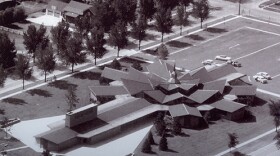If you've ever driven through farm country in Michigan’s thumb, you might have come across an octagon shaped barn. But there's more behind the iconic structure than you might know.
It was built in the roaring 20’s by a local banker who not only dabbled in architecture he also may be considered a creative genius.
In Tuscola County just east of Gagetown. “The Friends of the Octagon Barn” have the barn preserved, making it feel as if you’re on a farm in the early twentieth century. 1923 to be exact.
“My brother and I we’d come out here and we had a BB-gun and my grandma would give us two cents for every sparrow we killed”.
George Wilson is the grandson of James Purdey, he’s the Gagetown banker who built the barn. Wilson said his grandfather wasn't crazy, just curious. This was a time before television, and radio was just a toddler. Purdey’s innate sense of curiosity lead him to build an architectural anomaly.
“The earthquake went through San Francisco and he couldn't imagine it. So he got a train and rode to San Francisco because he wanted to see the damage. And as he’s going out there, the train stopped in every town. So he talking to this one and that one and in all those plain states you’ll see once in awhile a little round barn. They said those little round barns are wind proof. That's why he wanted to built this one”.
Wilson said his grandfather didn't waste any time starting the project.
“And when he got back, he got the carpenters, and they went back out to Iowa to study them”.
Wilson said he thinks his grandfather had the “go big or go home” mindset. He said the barns in Iowa don't even begin to compare to the octagon barn Purdey built.
“The ones in Iowa are just small. They’re just small. They’re like a silo that's probably 25 to 30 feet across”.
Purdey called his 70 foot tall structure his wind castle. Wilson said he built it basically for fun and to have somewhere to put his hobby cattle.
“One guy said oh my gosh if that wasn't a hell of a waste of money. I said, you know what, he had the money to do it. Now I said you know there’s a lot of farmers around here trying to keep up with their neighbors. They had to buy a new tractor, they had to put in a milking parlor, and they went bankrupt. I said, he didn't go bankrupt, he had the money to do it so he did it”.
Wilson said his grandfather’s body was in proportions to the size of his brain for he was an innovator, always looking to expand his mind.
“Well he was really tall, he wasn't big around but he was tall”.
Wilson’s wife Glenda said she believes Purdey’s innovative mind is what kept his bank afloat when the great depression hit. She said his bank is only one of two in Michigan that did not dissolve when people lost faith in banking systems and pulled all of their money out.
“He got silver dollars shipped in from detroit every day. So if people wanted their money from the bank he would give it to them in silver dollars, and some of it was so heavy and so bundlesome. So they were discouraged with that and it would discourage them from taking the money out”.
Glenda said it makes sense and it's genius really. She said there’s a reason why they don't make silver dollars anymore -- nobody wanted them.
Wilson said his grandfather received a telegram one morning and the contents of that letter made the creative gears in Purdey’s mind start spinning again. This time, his innovation would forever change the banking system across the country.
“My grandfather gets another telegram - the bank isn't open, he went down and, whoever they hired took the money and left. So, he had this house insured, he had that house insured, he had the cars, and cows, and stuff insured, but they didn't have the money insured. So he wrote an insurance policy, went to the governor of michigan, and they went to washington, and that started what is now called - the FDIC”.
The FDIC or the Federal Deposit Insurance Corporation became a crucial part of the Banking Act of 1933. The FDIC initially insured people’s accounts for up to $2,500. It revived American’s trust in the banking system and helped the country come out of the depression.
Small town banker, and innovator from Gagetown, James Purdey not only built one of the nation's largest octagon barns he also created the FDIC. The system economist Milton Friedman called the single most important structural change in the economy since the civil war.



